We bleed the hydraulic drive of the brake system after its repair, which resulted in a violation of the tightness of the system and if air is suspected of getting into the system
In the latter case, you must first determine and eliminate the cause of air getting into the hydraulic drive and only then begin bleeding it.
The presence of air in the hydraulic drive of the brake system is determined by the behavior of the brake pedal: it becomes soft (you can’t feel the stop at the end of the pedal stroke) and drops below its normal position.
To complete the work you will need an assistant, as well as:
- - a special wrench for the bleeder fitting or an 8 mm socket wrench;
- - transparent vinyl tube of suitable diameter;
- - container for draining brake fluid;
- - new brake fluid recommended by the manufacturer.
- - inspection ditch or overpass (preferably).
- 1. We prepare the car for the job.
- 2. Disconnect the wiring harness block from the connector of the low brake fluid level sensor and remove the reservoir cap
To prevent air from entering the hydraulic drive of the brake system when bleeding the drive, make sure that the brake fluid level in the reservoir does not fall below the MIN mark.
If the rear axle of the car is suspended (the car is on a lift or placed on stands), the pressure regulator will block the path of brake fluid to the rear wheel cylinders
Therefore, to bleed the rear wheel cylinders, it is necessary to open the regulator valve.
- 3. To open the pressure regulator valve, insert the blade of a slotted screwdriver between the lever and the plate, recessing the regulator rod.
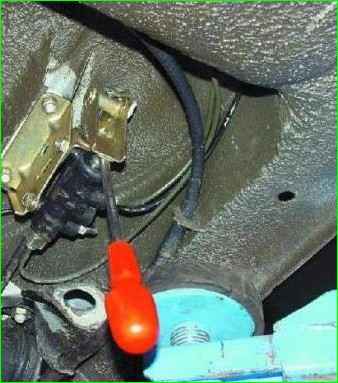
4. We clean the brake cylinder fitting of the rear right wheel and the surface around it from dirt.
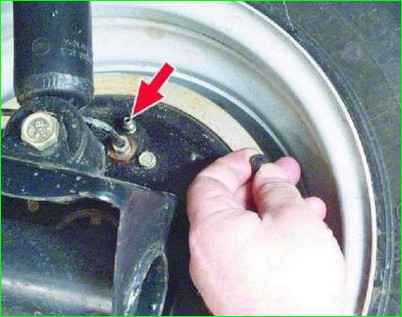
- 5. Remove the protective rubber cap from the bleeder fitting.
- 6. We put a special or 8 mm spanner on the bleeder fitting, and then a transparent vinyl tube (the diameter of the tube should be such that it fits tightly on the fitting), lower the other end of the tube into a transparent container partially filled with brake fluid.
- 7. The assistant presses the brake pedal several times and, after the last press, holds the pedal in the lower position.
- 8. Loosen the fitting, unscrew it approximately half a turn until liquid begins to flow out of the fitting.
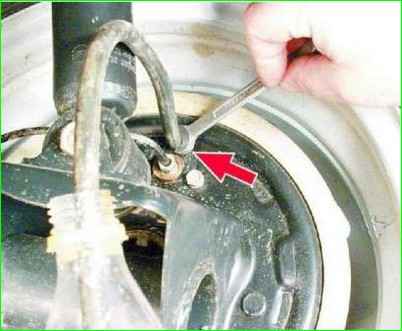
- 9. After the brake fluid stops coming out of the tube, tighten the fitting.
- 10. The assistant again presses the pedal several times and holds it pressed.
- 11. We repeat the steps described in paragraphs 7 and 8 (see above).
- 12. We carry out bleeding until the release of brake fluid with air bubbles from the cylinder fitting stops, after which we finally tighten the fitting.
- 13: Remove the vinyl tube and spanner from the fitting, put a protective rubber cap on the fitting.
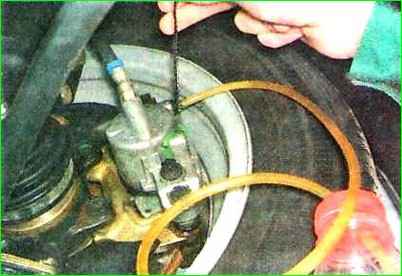
- 14. Next, bleed the brake cylinder of the front left wheel.
- 15. We pump the secondary circuit cylinders in the same way:
- rear left and front right wheels in the specified order, monitoring the fluid level in the master cylinder reservoir.
- 16. By pressing the brake pedal, we check the operation of the hydraulic drive and the absence of fluid leakage from the bleeder fittings.
If the pedal is soft or it drops below its normal operating position, re-check that the system is tight and repeat bleeding the hydraulic drive.
Replacing brake fluid
To complete the work you will need an assistant, as well as a rubber bulb.
1. We prepare the vehicle and necessary equipment for the job.
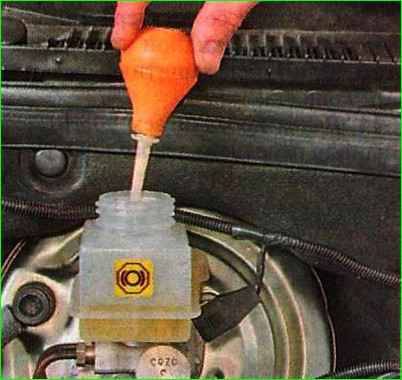
2. Remove the tank cover
To avoid getting into When replacing the brake fluid, make sure that the level in the reservoir does not fall below the MIN mark.
- 3. Use a blower to remove the working fluid from the master brake cylinder reservoir.
- 4. Fill the reservoir with new fluid up to the top edge of the reservoir.
- 5. We pump the circuits of the hydraulic drive system, starting with the rear wheels of the car.
- 6. We pump each wheel cylinder until new (lighter) brake fluid begins to emerge from the fitting.
- 7. After replacing the fluid in both circuits, we check the operation of the hydraulic drive and bring the fluid level in the master brake cylinder reservoir to normal.





